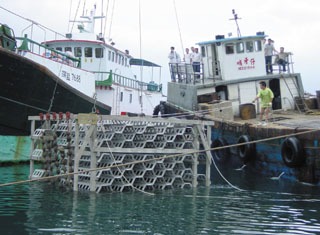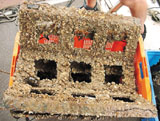|
.gif)
Barnacles,
mussels and other shellfish are being used by Hong Kong researchers in
an innovative way; as a biofiltering system to clean up fish farms.
 The shellfish
are usually regarded by sailors as a nuisance as they form thick growth
on the hulls of ships and impede speed and fuel efficiency. The shellfish
are usually regarded by sailors as a nuisance as they form thick growth
on the hulls of ships and impede speed and fuel efficiency.
 |
| An
artificial reef being lowered into position (above); build-up of barnacle
growth (right) |
 |
An
important characteristic of the shellfish being used by the researchers,
however, is that they are filter feeders, feeding on bacteria and nutrients
found in the sea.
 Three years
ago the City University of Hong Kong researchers began a study to determine
how effective the shellfish would be in disposing of debris such as feed
waste and fish excreta produced at fish farms. Three years
ago the City University of Hong Kong researchers began a study to determine
how effective the shellfish would be in disposing of debris such as feed
waste and fish excreta produced at fish farms.
 Nutrients from
the debris, mainly carbon, nitrogen and phosphorus, can cause significant
marine pollution. Nutrients from
the debris, mainly carbon, nitrogen and phosphorus, can cause significant
marine pollution.
 In the research,
artificial reefs, with a total surface area of 4,000 square metres for the
shellfish to grow on, were constructed and introduced into a fish culture
zone off Kau Sai Chau, near Sai Kung. In the research,
artificial reefs, with a total surface area of 4,000 square metres for the
shellfish to grow on, were constructed and introduced into a fish culture
zone off Kau Sai Chau, near Sai Kung.
 With growth
on the biofilter well established, it was calculated that its filtering
creatures removed an average of 6.4 kg of carbon, 1.7 kg of nitrogen, and
0.3 kg of phosphorus a day from the fish farm. For the nitrogen count, it
was the equivalent of that produced by two tonnes of fish a year. With growth
on the biofilter well established, it was calculated that its filtering
creatures removed an average of 6.4 kg of carbon, 1.7 kg of nitrogen, and
0.3 kg of phosphorus a day from the fish farm. For the nitrogen count, it
was the equivalent of that produced by two tonnes of fish a year.
 “We couldn’t
clean up Victoria Harbour with this method,” said Principal Investigator
Prof Paul K S Shin, “but, as a localised biofiltering system, it has
proved very effective.” “We couldn’t
clean up Victoria Harbour with this method,” said Principal Investigator
Prof Paul K S Shin, “but, as a localised biofiltering system, it has
proved very effective.”
 The most efficient
filtering shellfish were found to be barnacles and edible green-lipped mussels. The most efficient
filtering shellfish were found to be barnacles and edible green-lipped mussels.
 Part of the
research looked at whether it would be commercially viable to harvest green-lipped
mussels from the biofiltering reef, reaping a double-edged benefit by combining
the mussel’s
culture and filtering capacity. Part of the
research looked at whether it would be commercially viable to harvest green-lipped
mussels from the biofiltering reef, reaping a double-edged benefit by combining
the mussel’s
culture and filtering capacity.
 “Because
the mussels are relatively inexpensive, it’s
unlikely that growing them this way would be attractive to fishermen. We
may try oysters and scallops which sell at a higher price,” said Dr
Shin. “Because
the mussels are relatively inexpensive, it’s
unlikely that growing them this way would be attractive to fishermen. We
may try oysters and scallops which sell at a higher price,” said Dr
Shin.
 In all, about
200 strands of rope with mussel colonies were hung on the outside of the
biofiltering reef blocks for easy access. In all, about
200 strands of rope with mussel colonies were hung on the outside of the
biofiltering reef blocks for easy access.
 The reef comprised
16 blocks of a honeycomb structure made from cement and glass fibre. The reef comprised
16 blocks of a honeycomb structure made from cement and glass fibre.
 A
large tank at the fish farm and a small tank at the biofilter were set up
to measure the filtration rate. A
large tank at the fish farm and a small tank at the biofilter were set up
to measure the filtration rate.
 Water from the
large tank of unfiltered fish farm waste was pumped continuously to the
small tank containing a 10 cm by 10 cm plate encrusted with the filter feeders. Water from the
large tank of unfiltered fish farm waste was pumped continuously to the
small tank containing a 10 cm by 10 cm plate encrusted with the filter feeders.
 The concentration
of nutrient particulates was compared. “By measuring the depletion
of particulates in the small tank, we knew the filtration rate of the filter
feeders,” said Dr Shin, “because the depletion could only be caused
by animals on the plate.” The concentration
of nutrient particulates was compared. “By measuring the depletion
of particulates in the small tank, we knew the filtration rate of the filter
feeders,” said Dr Shin, “because the depletion could only be caused
by animals on the plate.”
 One precaution
taken in the experiment was to determine the source of the raw nutrients
being measured as they could have come from outside the fish farm. One precaution
taken in the experiment was to determine the source of the raw nutrients
being measured as they could have come from outside the fish farm.
 For this, a
stable isotope technique was used and confirmed that most came from the
fish farm. For this, a
stable isotope technique was used and confirmed that most came from the
fish farm.
 Analysis showed
that 68 percent of nutrients came from phytoplankton, 28 percent from trash
fish, and 4 percent from excrement. Analysis showed
that 68 percent of nutrients came from phytoplankton, 28 percent from trash
fish, and 4 percent from excrement.
 The filter feeders
solve the pollution problem in two ways, explained Dr Shin. The filter feeders
solve the pollution problem in two ways, explained Dr Shin.
 As well as digesting
particles of feed waste and fish excreta they also consume phytoplankton
which thrives on inorganic nutrients such as phosphorus and nitrogen. As well as digesting
particles of feed waste and fish excreta they also consume phytoplankton
which thrives on inorganic nutrients such as phosphorus and nitrogen.
 With
more nutrients, phytoplankton can form algal bloom or “red tides,”
he said, some of which can become toxic. With
more nutrients, phytoplankton can form algal bloom or “red tides,”
he said, some of which can become toxic.
 Research into
the biofilter system was funded by the Agriculture, Fisheries and Conservation
Department. Research into
the biofilter system was funded by the Agriculture, Fisheries and Conservation
Department.
 The filtering
artificial reef system has high application potential in the Asia-Pacific
region, said Dr Shin. The filtering
artificial reef system has high application potential in the Asia-Pacific
region, said Dr Shin.
Principal Investigator
Dr Paul K S Shin : bhpshin@cityu.edu.hk

|

![]()
![]() The shellfish
are usually regarded by sailors as a nuisance as they form thick growth
on the hulls of ships and impede speed and fuel efficiency.
The shellfish
are usually regarded by sailors as a nuisance as they form thick growth
on the hulls of ships and impede speed and fuel efficiency.

